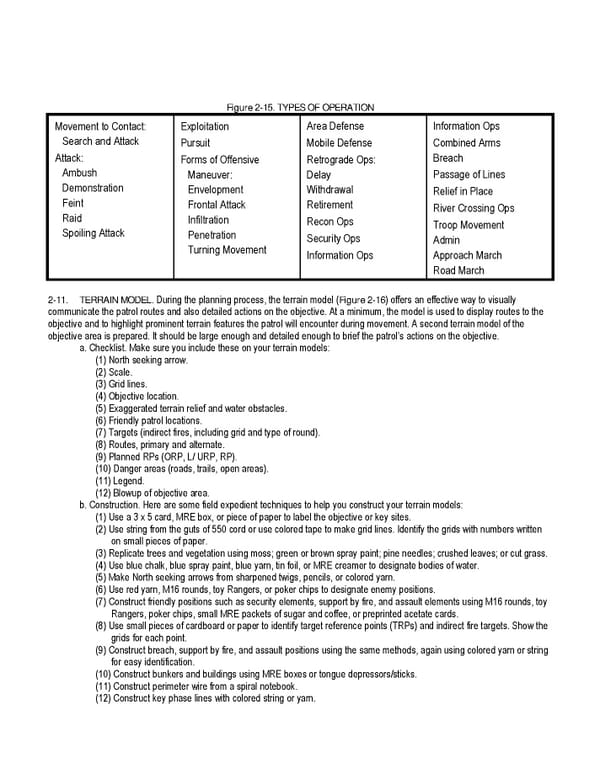Figure 2-15. TYPES OF OPERATION Movement to Contact: Search and Attack Attack: Ambush Demonstration Feint Raid Spoiling Attack Exploitation Pursuit Forms of Offensive Maneuver: Envelopment Frontal Attack Infiltration Penetration Turning Movement Area Defense Mobile Defense Retrograde Ops: Delay Withdrawal Retirement Recon Ops Security Ops Information Ops Information Ops Combined Arms Breach Passage of Lines Relief in Place River Crossing Ops Troop Movement Admin Approach March Road March 2-11. TERRAIN MODEL. During the planning process, the terrain model (Figure 2-16) offers an effective way to visually communicate the patrol routes and also detailed actions on the objective. At a minimum, the model is used to display routes to the objective and to highlight prominent terrain features the patrol will encounter during movement. A second terrain model of the objective area is prepared. It should be large enough and detailed enough to brief the patrol’s actions on the objective. a. Checklist. Make sure you include these on your terrain models: (1) North seeking arrow. (2) Scale. (3) Grid lines. (4) Objective location. (5) Exaggerated terrain relief and water obstacles. (6) Friendly patrol locations. (7) Targets (indirect fires, including grid and type of round). (8) Routes, primary and alternate. (9) Planned RPs (ORP, L/ URP, RP). (10) Danger areas (roads, trails, open areas). (11) Legend. (12) Blowup of objective area. b. Construction. Here are some field expedient techniques to help you construct your terrain models: (1) Use a 3 x 5 card, MRE box, or piece of paper to label the objective or key sites. (2) Use string from the guts of 550 cord or use colored tape to make grid lines. Identify the grids with numbers written on small pieces of paper. (3) Replicate trees and vegetation using moss; green or brown spray paint; pine needles; crushed leaves; or cut grass. (4) Use blue chalk, blue spray paint, blue yarn, tin foil, or MRE creamer to designate bodies of water. (5) Make North seeking arrows from sharpened twigs, pencils, or colored yarn. (6) Use red yarn, M16 rounds, toy Rangers, or poker chips to designate enemy positions. (7) Construct friendly positions such as security elements, support by fire, and assault elements using M16 rounds, toy Rangers, poker chips, small MRE packets of sugar and coffee, or preprinted acetate cards. (8) Use small pieces of cardboard or paper to identify target reference points (TRPs) and indirect fire targets. Show the grids for each point. (9) Construct breach, support by fire, and assault positions using the same methods, again using colored yarn or string for easy identification. (10) Construct bunkers and buildings using MRE boxes or tongue depressors/sticks. (11) Construct perimeter wire from a spiral notebook. (12) Construct key phase lines with colored string or yarn.
 Ranger Handbook Page 51 Page 53
Ranger Handbook Page 51 Page 53